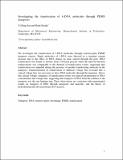Investigating the translocation of lambda-DNA molecules through PDMS nanopores
Author(s)
Karnik, Rohit; Sen, Yi-heng
DownloadPaper for Dspace_JS_RK.pdf (2.276Mb)
PUBLISHER_POLICY
Publisher Policy
Article is made available in accordance with the publisher's policy and may be subject to US copyright law. Please refer to the publisher's site for terms of use.
Alternative title
Investigating the translocation of λ-DNA molecules through PDMS nanopores
Terms of use
Metadata
Show full item recordAbstract
We investigate the translocation of λ-DNA molecules through resistive-pulse polydimethylsiloxane (PDMS) nanopore sensors. Single molecules of λ-DNA were detected as a transient current increase due to the effect of DNA charge on ionic current through the pore. DNA translocation was found to deviate from a Poisson process when the interval between translocations was comparable to the duration of translocation events, suggesting that translocation was impeded during the presence of another translocating molecule in the nanopore. Characterization of translocation at different voltage biases revealed that a critical voltage was necessary to drive DNA molecules through the nanopore. Above this critical voltage, frequency of translocation events was directly proportional to DNA concentration and voltage bias, suggesting that transport of DNA from the solution to the nanopore was the rate limiting step. These observations are consistent with experimental results on transport of DNA through nanopores and nanoslits and the theory of hydrodynamically driven polymer flow in pores.
Description
Sen, Yi-Heng, and Rohit Karnik. “Investigating the translocation of λ-DNA molecules through PDMS nanopores.” Analytical and Bioanalytical Chemistry 394.2 (2009): 437-446.
Date issued
2008-12Department
Massachusetts Institute of Technology. Department of Mechanical EngineeringJournal
Analytical and Bioanalytical Chemistry
Publisher
Springer Berlin Heidelberg
ISSN
1618-2650
1618-2642
Keywords
PDMS, nanopore, translocation, resistive-pulse, DNA, biosensing